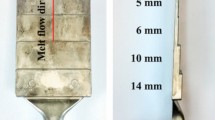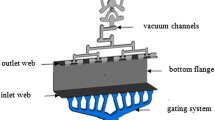Abstract
In-die temperature measurements during the casting of 3.5- and 11.7-mm-thick disks in metal dies at 100 °C, 200 °C, and 400 °C enables calculation of the heat flux from the casting to the die as a function of the casting parameters. Using the flux so determined, the temperature field in the plates could be calculated in agreement with measured values. Increasing preheating temperatures reduced the heat flux, which extended the local solidification time and coarsened the structure. Directional solidification, from the wall of the die to the center of the disk, took place only when casting a thin disk in a die at 400 °C, because of the combination of low undercooling (which prevents homogeneous nucleation) and a sufficiently steep temperature gradient at the solidification front to ensure directional growth. A relatively long residence time at the high temperature, as occurs during casting in a die at 400 °C, leads to a more-uniform distribution of the Al, due to diffusion in the solid, and prevents the divorced eutectic, distinct from that obtained at slow solidification, of the AZ91D ingot.
Similar content being viewed by others
References
M. Bamberger and A. Rosenberg: Giessereiforschung, 1992, vol. 44 (3), pp. 121–25.
K.N. Prabhu, G. Srinvas, and N. Venkataraman: AFS Trans., 1993, vol. 101, pp. 653–59.
K.N. Prabhu, G. Srinvas, and N. Venkataraman: AFS Trans., 1994, vol. 102, pp. 827–32.
M. Bamberger, B.Z. Weiss, and M.M. Stupel: Mater. Sci. Technol., 1987, vol. 3, pp. 49–56.
Kai Ho and R.D. Pehlke: Metall. Trans. B, 1985, vol. 16B, pp. 585–94.
C.A. Muojekwu, I.V. Samarasekera, and J.K. Brimacombe: Metall. Mater. Trans. B, 1995, vol. 26B, pp. 361–82.
G.B. Harris: Phil. Mag., 1952, vol. 43, pp. 113–23.
K. Pettersen and N. Ryum: Metall. Trans. A, 1989, vol. 20A, pp. 847–52.
K. Pettersen, O. Lohne and N. Ryum: Metall. Mater. Trans. A, 1990, vol. 21A, pp. 221–30.
Merton C. Flemings: Materials Science and Engineering Series—Solidification Processing, McGraw-Hill Book Company, New York, NY, 1974.
A. Luo: Proc. 3rd Int. Magnesium Conf., Manchester, United Kingdom, Apr. 10–12, 1996, Institute of Materials, London, UK, 1997, pp. 449–64.
B. Bronfin and E. Aghion: Proc. 3rd Int. Magnesium Conf., Manchester, United Kingdom, Apr. 10–12, 1996, Institute of Materials, London, UK, 1997, pp. 313–25.
Robert W. Cahn: Physical Metallurgy, 4th ed., North-Holland, Amsterdam, 1996, vol. 1, pp. 669–830.
D.J. Sakkinen: SAE Technical Paper Series 940779, The Dow Chemical Co., Freeport, Tx.
Author information
Authors and Affiliations
Rights and permissions
About this article
Cite this article
Avishei, A., Bamberger, M. Relation between cooling rates and microstructures in gravity-die-cast AZ91D disks. Metall Mater Trans B 30, 723–729 (1999). https://doi.org/10.1007/s11663-999-0034-5
Received:
Issue Date:
DOI: https://doi.org/10.1007/s11663-999-0034-5




